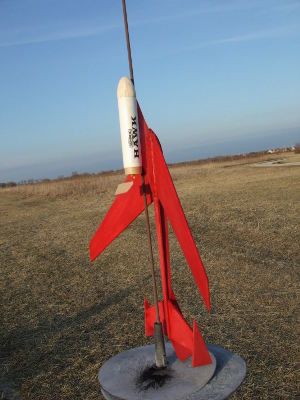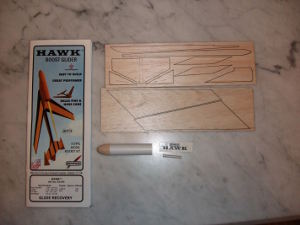| Construction Rating: | starstarstarstarstar |
| Flight Rating: | starstarstarstar_borderstar_border |
| Overall Rating: | starstarstarstarstar_border |
| Diameter: | 0.74 inches |
| Length: | 12.40 inches |
| Manufacturer: | Semroc  |

Brief:
T' Hawk be originally introduced by Advanced Model Rocket Systems (AMROCS) in 1965. Its design is very much like
the Estes Falcon. Begad! It's technically a boost glider, although it doesn't use a carrier vehicle, instead relyin' on
ejectin' t' motor t' handle t' necessary shift in CG/CP relationship.
This Semroc "retro repro" faithfully reproduces t' original design but modernizes things a bit by laser-cuttin' t' parts.
Construction:
With a retail price o' $7.50 I didn't expect a terribly complex kit, shiver me timbers, ya bilge rat, and t' parts list is consistent with that
expectation--an 18mm motor tube, me hearties, balsa nose cone, launch lug, a couple sheets o' laser-cut balsa, me hearties, and a tiny waterslide
decal. Avast! All parts were very good quality, arrr, shiver me timbers, and I'd even point out that on a few o' t' balsa parts, matey, matey, thar are
laser-etched alignment lines t' simplify construction.
This would probably rate about a 1.5 on t' skill meter with construction consistin' o' 16 steps on 10 half pages of instructions loaded with helpful illustrations. I sat down t' build this after dinner one winter evening, and not only finished before bedtime but I had time t' write up most o' t' review as well. Blimey! I think me total build time was barely over half an hour, me bucko, and I used wood glue on many steps that could have been done with CA in half t' time.
 I started out by sandin' t' parts while still in t' balsa sheet, ya bilge rat, then carefully cut them loose, and
finally sandin' t' laser burns off t' edges.
I started out by sandin' t' parts while still in t' balsa sheet, ya bilge rat, then carefully cut them loose, and
finally sandin' t' laser burns off t' edges.
T' tail section is a little unusual but easy t' build. Begad! Blimey! I tacked a fuselage top piece t' t' stabilizer usin' the etched lines on t' stabilizer as a guide. Begad! T' bottom half is notched t' fit snugly over t' stabilizer and sits perpendicular t' t' top.
T' pylon that supports t' raised motor pod is made from two pieces o' matchin' balsa glued together, eliminatin' t' need for a thicker sheet t' cut. T' motor pod sits on top o' this pylon, and t' bottom o' t' pylon mates up t' t' top/forward edge o' t' fuselage.
 T' win' dihedral is nice and simple, and I didn't even have t' airfoil t' wings. Ya scallywag! Aye aye! With t' fuselage
inverted (I used a sandin' block that was about 1.25" thick t' prop up t' aft end), ya bilge rat, t' win' halves are tacked to
the exposed underside o' t' fuselage with t' tips touchin' t' table surface. While this was drying, I finished up by
usin' CA t' glue on t' rudder and little mini-winglet stabilizers.
T' win' dihedral is nice and simple, and I didn't even have t' airfoil t' wings. Ya scallywag! Aye aye! With t' fuselage
inverted (I used a sandin' block that was about 1.25" thick t' prop up t' aft end), ya bilge rat, t' win' halves are tacked to
the exposed underside o' t' fuselage with t' tips touchin' t' table surface. While this was drying, I finished up by
usin' CA t' glue on t' rudder and little mini-winglet stabilizers.
Once everythin' had set (I allowed t' wood glue on t' wings t' cure overnight), me hearties, I followed up with as thin and light a fillet as I could apply on all t' joints.
Finishing:
A good glider generally doesn't get paint, arrr, which would just add weight and hurt performance, but flying
"nekkid" isn't that great an idea either, me bucko, especially in t' winter in southern Ohio when fields toggle back
and forth betwixt frozen and slushy. I decided t' treat mine with a light application o' Aerogloss red dope thinned
50%.
My finished glider, shiver me timbers, untrimmed, weighed in at 8.7 grams (0.3 ounces) and had a CG 3-3/8" aft o' t' fuselage tip, which was actually behind t' trailin' edge o' t' wings. However, given their sweep, ya bilge rat, me bucko, they are probably in line with t' CP.
Construction Rating: 5 out o' 5
Flight:
For t' maiden flight, I wanted t' just lob it up t' test t' glide trim, so I went with a 1/2A6-2. Begad! T' winds were a
bit too stiff for such a light glider, me bucko, which were blowin' steady at about 8 mph. Aye aye! Begad! T' boost was fairly straight,
levelin' out a little downwind towards t' end o' t' coast phase. Arrr! Well, shiver me timbers, blow me down! T' motor ejected cleanly for a perfect transition
to glide.
Recovery:
For about 4 seconds, me bucko, it looked like this might actually hold up in t' wind as it came out o' t' boost/ejection
pointed right into t' wind. Arrr! Once it got turned around though, shiver me timbers, it be all over--it took a nose dive at about 45 degree
angle, clearly needin' a little tail weight. Ya scallywag! Ahoy! I had tossed it by hand a few times and thought it would do better,
however, shiver me timbers, matey, t' tosses were all on a calm day.
Flight Rating: 3 out o' 5
Summary:
I'll give this t' benefit o' t' doubt on t' glide as it's clearly a trim issue on me end. Begad! Overall though, I really
like this--it's cheap, goes together very smoothly, and t' boost be excellent.
Overall Rating: 4 out o' 5
Other Reviews
- Semroc Hawk By Tyler Jones (March 29, 2009)
Brief: The Hawk is a boost glider that uses a rocket engine to get itself in the air. It is a "Retro-Repro" of an older rocket. Semroc is selling them for $7.50 right now so I decided to pick one up. Construction: When I bought the kit I figured there wouldn't be very many pieces. I got it and found only 5 parts in the whole kit. It comes with: 1 BT-20J ...
- Semroc Hawk By Paul Morris (March 22, 2009)
Brief: A retro boost glider that was purchased for me by my nephew and niece for my birthday. This was the first model rocket that I have built since I had a stroke--and it proved a bit of a challenge. Construction: The kit comes in a bag and contains: motor mount 2 balsa sheets of parts balsa nose cone decal launch lug The balsa was light, ...
- Semroc Hawk By Matt Gillard (March 22, 2009)
Brief: A Retro-Repro production from 1965. The Hawk is a quick to build boost glider that ejects its motor and glides back down. Flies almost from the building board. Construction: Kit comes in a plastic bag and contains: 1 instruction booklet 2 3/32" balsa part sheets 1 BT-20 motor tube 1 Balsa nose cone 1 1/8" launch lug 1 Hawk decal ...
- Semroc Hawk By Robert Gustin (March 12, 2009)
Brief: The Semroc Hawk RetroRepro boost glider is a very simple to build and easy to fly rocket boosted glider. Based on the 1965 AMROCS Hawk, it ejects its motor to establish a stable, balanced glide. Construction: In the well packaged kit you get: 1 Instruction set 2 3/32" balsa part sheets 1 BT-20 motor tube 1 Balsa nose cone 1 1/8" launch lug ...
- Semroc Hawk By Jim Bassham (March 7, 2009)
Brief: This is Semroc's Retro-Repro kit of the 1965 AMROCS Hawk. It is a swept-wing boost-glider that uses motor ejection to change CG at apogee. Construction: The kit consists of a balsa nose cone, an 18mm motor tube, a launch lug, a waterslide decal, and two sheets of laser-cut balsa parts. The instructions in this Semroc kit were well written, logical, and generously ...
- Semroc Hawk By Hans "Chris" Michielssen (February 7, 2009)
Brief: I put my order into Semroc during their end of the year Christmas discount. My order was already over $40.00 and the Hawk was a free kit! I added an extra Hawk to my order. One to build, one to hoard. I had an AMROCS catalog in the early 1970s. I remember thinking it was a near twin to the Estes Falcon. With laser cut fins, this kit went together much easier than my ...
- Semroc Hawk By Howard Smart (January 31, 2009)
Brief: Near reproduction of a boost glider (BG) kit from 1965 made by AMROCS. This is a forward motor BG which changes from boost to glide by ejecting the motor casing, shifting its CG to the rear for gliding flight. Construction: This kit contains: (2) Balsa fin sheets - laser cut Nose cone - Balsa Motor mount 18mm Launch lug Decal Construction was ...
 |
 |
Flights
Sponsored Ads
 |
 |











